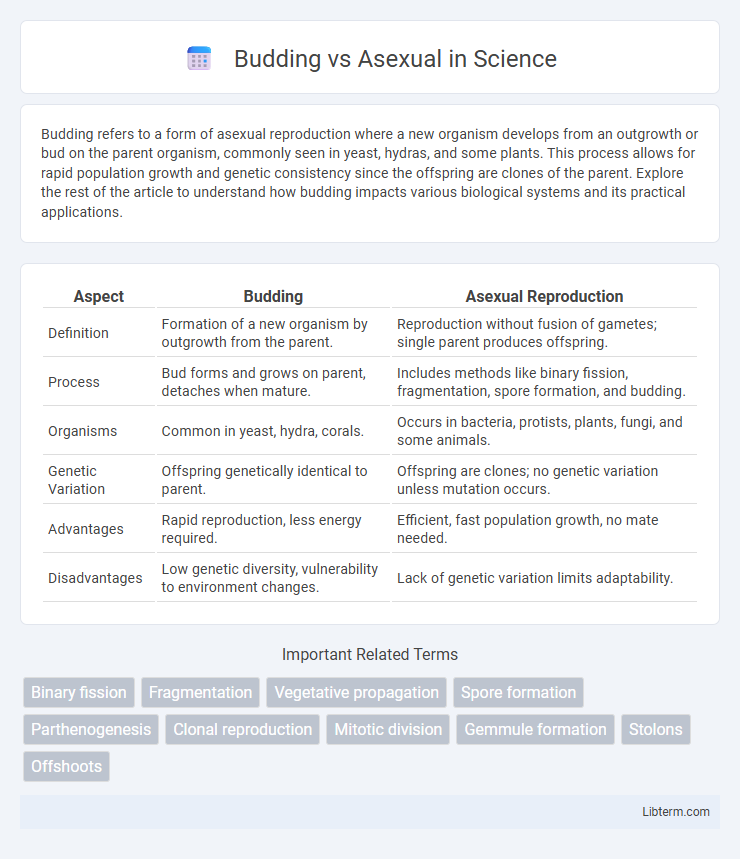Budding refers to a form of asexual reproduction where a new organism develops from an outgrowth or bud on the parent organism, commonly seen in yeast, hydras, and some plants. This process allows for rapid population growth and genetic consistency since the offspring are clones of the parent. Explore the rest of the article to understand how budding impacts various biological systems and its practical applications.
Table of Comparison
| Aspect | Budding | Asexual Reproduction |
|---|---|---|
| Definition | Formation of a new organism by outgrowth from the parent. | Reproduction without fusion of gametes; single parent produces offspring. |
| Process | Bud forms and grows on parent, detaches when mature. | Includes methods like binary fission, fragmentation, spore formation, and budding. |
| Organisms | Common in yeast, hydra, corals. | Occurs in bacteria, protists, plants, fungi, and some animals. |
| Genetic Variation | Offspring genetically identical to parent. | Offspring are clones; no genetic variation unless mutation occurs. |
| Advantages | Rapid reproduction, less energy required. | Efficient, fast population growth, no mate needed. |
| Disadvantages | Low genetic diversity, vulnerability to environment changes. | Lack of genetic variation limits adaptability. |
Introduction to Budding and Asexual Reproduction
Budding is a type of asexual reproduction where a new organism develops from an outgrowth or bud due to cell division at one particular site, common in organisms like yeast and hydra. Asexual reproduction involves a single parent producing genetically identical offspring without the involvement of gametes or fertilization, ensuring rapid population growth in favorable conditions. Both processes enable species survival and propagation through cloning, but budding specifically results in a new individual growing directly from the parent organism.
Defining Asexual Reproduction
Asexual reproduction is a mode of reproduction involving a single organism that produces offspring genetically identical to itself without the fusion of gametes. Budding is a specific type of asexual reproduction where a new individual develops from an outgrowth or bud due to cell division at one particular site. Unlike sexual reproduction, asexual reproduction, including budding, results in clones, ensuring rapid population growth and stability in stable environments.
What is Budding?
Budding is a form of asexual reproduction in which a new organism develops from an outgrowth or bud on the parent organism, eventually detaching to live independently. This process occurs in organisms such as yeast, hydra, and certain plants, allowing rapid population growth without genetic variation. Unlike other asexual methods like binary fission, budding produces offspring that initially remain attached to the parent before separation.
Key Differences Between Budding and Other Asexual Methods
Budding, a form of asexual reproduction, involves the growth of a new organism from a bud on the parent, which eventually detaches to become independent, distinguishing it from binary fission where the parent splits into two equal halves. Unlike fragmentation, where an organism breaks into parts that regenerate into whole organisms, budding produces a genetically identical but physically connected offspring initially. This method is common in organisms like yeast and hydra, highlighting a localized growth process rather than a complete division or regeneration seen in other asexual reproductive strategies.
Examples of Organisms That Reproduce by Budding
Organisms that reproduce by budding include hydra, yeast, and certain coral species. Hydra produces buds that develop into independent individuals through mitotic cell division, while yeast forms buds during asexual reproduction to generate genetically identical offspring. Coral polyps also reproduce by budding, enabling colony expansion and regeneration without genetic variation.
Examples of Other Asexual Reproduction Methods
Budding, a form of asexual reproduction where a new organism develops from an outgrowth or bud due to cell division at one particular site, is common in yeast and hydra. Other asexual reproduction methods include binary fission, observed in bacteria and amoebas, where the parent cell divides into two equal parts. Fragmentation, seen in starfish and planarians, involves an organism breaking into fragments, each capable of growing into a new individual, while spore formation in fungi and ferns allows reproduction through specialized cells.
Biological Advantages of Budding
Budding provides biological advantages by enabling rapid population growth and genetic stability through mitotic reproduction, allowing organisms like yeast and hydra to efficiently colonize environments. Unlike other forms of asexual reproduction, budding produces offspring that remain attached to the parent organism for a time, facilitating resource sharing and protection during early development. This method also minimizes energy expenditure compared to sexual reproduction, enhancing survival in stable, resource-rich habitats.
Ecological Significance of Asexual Reproduction
Asexual reproduction, including budding, enables rapid population growth without the need for mates, allowing species to quickly exploit favorable environmental conditions. This mode of reproduction ensures genetic stability, which helps maintain successful adaptations in stable ecosystems. In contrast, budding specifically facilitates localized colonization, contributing to resilience and persistence in habitats with limited resource variability.
Budding vs Asexual Reproduction: Evolutionary Implications
Budding, a form of asexual reproduction, involves the growth of a new organism from a localized site on the parent, allowing rapid population increase without genetic variation, which limits adaptability in changing environments. Asexual reproduction, including methods like binary fission and spore formation, produces genetically identical offspring, promoting stability in stable conditions but reducing evolutionary potential. The evolutionary implications of budding versus broader asexual reproduction center on the balance between reproductive efficiency and genetic diversity essential for long-term species survival.
Conclusion: Which Reproductive Method Prevails?
Budding and asexual reproduction both offer efficient means of generating offspring without genetic variation, but asexual reproduction prevails in its broader adaptability and species diversity due to its multiple mechanisms such as binary fission, fragmentation, and spore formation. Budding is a specialized form of asexual reproduction mainly observed in organisms like hydras and yeast, providing rapid population growth in stable environments. The dominance of asexual reproduction methods in nature is evident through their widespread presence across diverse taxa, facilitating survival in various ecological niches.
Budding Infographic

 libterm.com
libterm.com